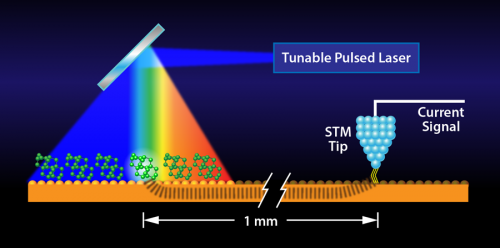September 24, 2013 report
Researchers devise means to combine scanning tunneling microscopy and infrared spectroscopy

(Phys.org) —A team of researchers at the University of California with members also from Lawrence Berkeley National Laboratory and Stanford University has succeeded in combining tunneling microscopy and infrared spectroscopy to gain a better understanding of how molecules behave when they stick to a surface. In their paper published in the journal Physical Review Letters, the team describes how they used a custom built laser to allow for performing infrared spectroscopy with scanning tunneling microscopy without heating its tip.
Scanning tunneling microscopy is able to gather information at the atomic level of a material by making use of a tiny tip that is placed near a material and then measuring the amount of current that passes between the tip and the material. Using this method, researchers can gather information about individual molecules and atoms, but cannot distinguish between them. Infrared spectroscopy gathers information about a material via a laser focused on a sample—infrared light is bounced off the material and differences in frequencies reveal which types of molecule are present. Unfortunately, the technique is not precise enough to single out individual atoms that make up the molecules. In this new effort, the researchers set out to combine the two technologies to allow for gaining the benefits of both, while negating their individual drawbacks.
To overcome problems with laser heat impacting the scanning tip, the researchers used a custom built laser that was capable of irradiating a gold surface upon which tetramantane or tetramantane crystals had been deposited. The scanning tip was placed far enough away from the surface to avoid being impacted. When the laser was fired, the team found that the current between the tip and the surface increased when its frequency was set to that of one of the crystals' absorption frequencies. By measuring the increase, the researchers were able to determine which crystal had been absorbed into the gold substrate. This meant that the team had combined the best attributes of both types of scanning devices.
The only downside the team reported was that the scanner was only able to use the average signal from a set group of molecules rather than single molecules—they plan to continue their work with the combined devices with the hope of refining the process to allow for both analyzing and identifying molecules at the nanoscale. By comparing such molecules in a free group with those adhering to a surface, the researchers hope to gain new insight into how molecules behave when attaching themselves to a surface.
More information: Infrared Spectroscopy of Molecular Submonolayers on Surfaces by Infrared Scanning Tunneling Microscopy: Tetramantane on Au(111), Phys. Rev. Lett. 111, 126101 (2013). DOI: 10.1103/PhysRevLett.111.126101
Abstract
We have developed a new scanning-tunneling-microscopy–based spectroscopy technique to characterize infrared (IR) absorption of submonolayers of molecules on conducting crystals. The technique employs a scanning tunneling microscope as a precise detector to measure the expansion of a molecule-decorated crystal that is irradiated by IR light from a tunable laser source. Using this technique, we obtain the IR absorption spectra of [121]tetramantane and [123]tetramantane on Au(111). Significant differences between the IR spectra for these two isomers show the power of this new technique to differentiate chemical structures even when single-molecule-resolved scanning tunneling microscopy (STM) images look quite similar. Furthermore, the new technique was found to yield significantly better spectral resolution than STM-based inelastic electron tunneling spectroscopy, and to allow determination of optical absorption cross sections. Compared to IR spectroscopy of bulk tetramantane powders, infrared scanning tunneling microscopy (IRSTM) spectra reveal narrower and blueshifted vibrational peaks for an ordered tetramantane adlayer. Differences between bulk and surface tetramantane vibrational spectra are explained via molecule-molecule interactions.
Journal information: Physical Review Letters
© 2013 Phys.org



















